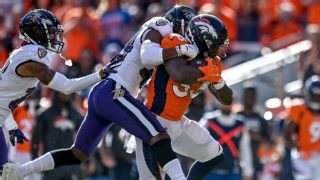|
ENGLEWOOD, Colo. -- Sir Isaac Newton's third law of motion, outlined in a playbook for the study of physics with the catchy little title of "Philosophiae Naturalis Principia Mathematica," is often presented as the law of action and reaction. That when an object exerts a force on another object, the second object exerts an equal and opposite force on the first. Spring ahead 335 years or so and Denver Broncos running back Javonte Williams offered his own contribution. The action of his 31-yard run against the Baltimore Ravens a little more than a week ago caused some folks to lose their minds. It took about nine seconds from the time Broncos quarterback Teddy Bridgewater handed Williams the ball to when the sixth Baltimore Ravens defender finally got Williams to the ground. And even though a week had passed, the run was so rare, so memorable, it was still being played over and over again, even by one Pittsburgh TV station this past Saturday shortly after the Broncos had arrived to their team hotel. "A good-ass run," as Broncos defensive end Shelby Harris called it. "I've never seen a play like that," Broncos linebacker Von Miller said. "I've been in the league 11 years, break tackles for 40 yards straight and almost tumbles into the end zone." So how did the 5-foot-10, 220-pound Williams -- not the biggest, strongest or fastest running back in the league -- generate more power than most? Broncos defensive coordinator Ed Donatell has labeled that kind of force from a tackler like safety Kareem Jackson as the "ability to harness the power from the ground." But there's more physics to it than that. We went to Chad Orzel, associate professor of physics and director of undergraduate research at Union College in Schenectady, N.Y., to get the science behind it. "It's a really rich subject because there is a lot going on, even in the things that are fairly simple in football," said Orzel. "There's a lot of physics going on, you've got so many moving parts. In physics we're famous for approximating everything as a sphere, football players are very not spherical and the ball isn't even spherical. But you look at the spin around the long axis, you look at the random bounce, things like that, it's a really rich subject physics-wise. "Still there are some things about football that are just harder to quantify in that way, but the physics end of it, the same mass moving at the same speed, the thing you can vary is the angle of the impact and that's what is going to make a difference. ... If you're trying to alter the collision somewhat, it's going to be less of an impact and the less the angle of impact is altered between the two objects the closer to maximum force will be delivered." Orzel, an avid New York Giants fan and a former rugby player who has written about the physics of football, reviewed the video clip of Williams' run and offered something that could be classified as a willingness component. "You can have two guys who are the same size and weight," Orzel said. "I'm the same height and weight as [Hall of Famer] Michael Strahan when he played and I'm simply not going to move anybody, exert the force required to move anybody, who plays in the NFL. I'm not." In 2020, at the University of North Carolina, Williams led the Power 5 conferences in broken tackles. There are some pro personnel evaluators in the league who say he currently leads the NFL in broken tackles after five weeks. He another a 49-yard run in Pittsburgh Sunday (Williams was penalized for spiking the ball after the play because he was mad he didn't score), on his way to 247 yards rushing on his 54 carries so far this season.  Through the years scouts have long tossed out phrases such as "center of gravity" as an explanation for some ball carriers or the "business decisions" that were made by those who missed the tackles. Earlier this season Williams simply offered, "I just don't want to go down on the first hit." Through the years scouts have long tossed out phrases such as "center of gravity" as an explanation for some ball carriers or the "business decisions" that were made by those who missed the tackles. Earlier this season Williams simply offered, "I just don't want to go down on the first hit."
Miller, who is now the longest tenured Broncos player, has seen plenty of rookies come and go. He decided to poke and prod Williams a little earlier this year. "He means business," Miller said. "For the longest [time], I didn't think he liked me at first, when he first got here he kind of stepped on my foot, and I'm like, 'Bro, what's going on?' And he gave me a look and I was like, 'Oh, this rookie is different.' ... I just wanted to test it out one day, I tried to trip him in the hallway. And he just kind of rolled up and kept going ... he just like has a sixth sense when it comes to breaking tacklers. His center of balance is incredible." "It's not the purest kind of physics where objects are just moving toward each other," Orzel said. "Some players have stronger legs, are stronger in their core of players of similar or same size, some haven't altered the angle at the collision, the other body involved has altered the angle or didn't quite reach him in time. Again, just a rich, rich subject."
|

